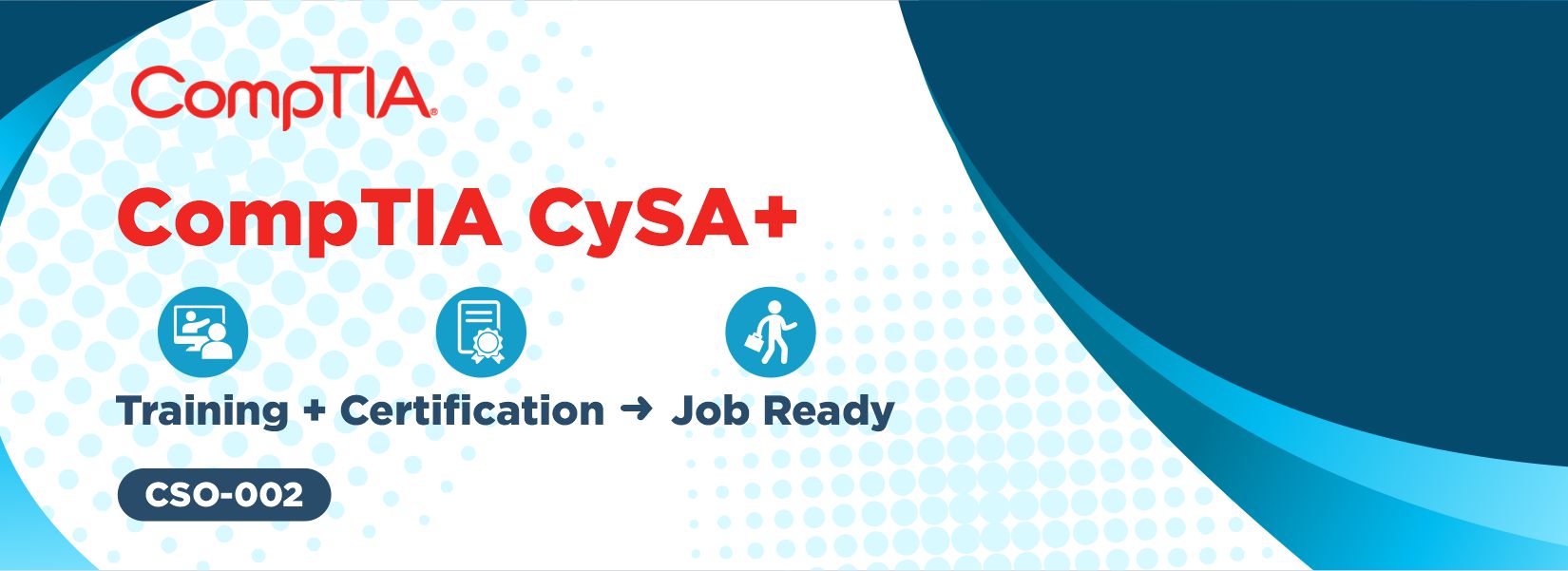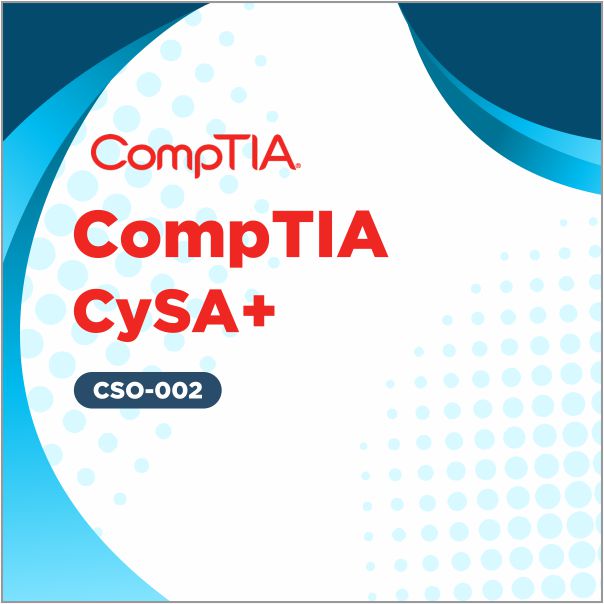CompTIA
CySA+ Course Outline
1.0 Threat and Vulnerability Management
1.1 Explain the importance of threat data and intelligence.
Intelligence sources
- Open-source intelligence
- Proprietary/closed-source intelligence
- Timeliness
- Relevancy
- Accuracy
Indicator management
- Structured Threat Information eXpression (STIX)
- Trusted Automated eXchange of Indicator Information (TAXII)
- OpenIoC
Threat classification
- Known threat vs. unknown threat
- Zero-day
- Advanced persistent threat
Threat actors
- Nation-state
- Hacktivist
- Organized crime
- Insider threat
- Intentional
- Unintentional
Intelligence cycle
- Requirements
- Collection
- Analysis
- Dissemination
- Feedback
Commodity malware
Information sharing and analysis communities
- Healthcare
- Financial
- Aviation
- Government
- Critical infrastructure
1.2 Given a scenario, utilize threat intelligence to support organizational security.
Attack frameworks
- MITRE ATT&CK
- The Diamond Model of Intrusion Analysis
- Kill chain
Threat research
- Reputational
- Behavioural
- Indicator of compromise (IoC)
- Common vulnerability scoring system (CVSS)
Threat modelling methodologies
- Adversary capability
- Total attack surface
- Attack vector
- Impact
- Likelihood
Threat intelligence sharing with supported functions
- Incident response
- Vulnerability management
- Risk management
- Security engineering
- Detection and monitoring
1.3 Given a scenario, perform vulnerability management activities.
Vulnerability identification
- Asset criticality
- Active vs. passive scanning
- Mapping/enumeration
Validation
- True positive
- False positive - True negative
- False negative
Remediation/mitigation
- Configuration baseline
- Patching
- Hardening
- Compensating controls
- Risk acceptance
- Verification of mitigation
Scanning parameters and criteria
- Risks associated with scanning activities
- Vulnerability feed
- Scope
- Credentialed vs. non-credentialed
- Server-based vs. agent-based
- Internal vs. external
- Special considerations
- Types of data
- Technical constraints
- Workflow
- Sensitivity levels
- Regulatory requirements
- Segmentation
- Intrusion prevention system (IPS), intrusion detection system (IDS), and firewall settings
Inhibitors to remediation
- Memorandum of understanding (MOU)
- Service-level agreement (SLA)
- Organizational governance
- Business process interruption
- Degrading functionality
- Legacy systems
1.4 Given a scenario, analyze the output from common vulnerability assessment tools.
Web application scanner
- OWASP Zed Attack Proxy (ZAP)
- Burp suite
- Nikto
- Arachni
Infrastructure vulnerability scanner
- Nessus
- OpenVAS
- Qualys
Software assessment tools and techniques
- Static analysis
- Dynamic analysis
- Reverse engineering
- Fuzzing
Enumeration
- Nmap
- hping
- Active vs. passive
- Responder
Wireless assessment tools
- Aircrack-ng
- Reaver
- oclHashcat
Cloud Infrastructure assessment tools
- ScoutSuite
- Prowler
- Pacu
1.5 Explain the threats and vulnerabilities associated with specialized technology.
- Mobile
- Internet of Things (IoT)
- Embedded
- Real-time operating system (RTOS)
- System-on-Chip (SoC)
- Field programmable gate array (FPGA)
- Physical access control
- Building automation systems
- Vehicles and drones
- CAN bus
- Workflow and process automation systems
- Industrial control system
- Supervisory control and data acquisition (SCADA)
- Modbus
1.6 Explain the threats and vulnerabilities associated with operating in the cloud.
Cloud service models
- Software as a Service (SaaS)
- Platform as a Service (PaaS)
- Infrastructure as a Service (IaaS)
Cloud deployment models
- Public
- Private
- Community
- Hybrid
Function as a Service (FaaS)/ server less architecture
Infrastructure as code (IaC)
Insecure application programming interface (API)
Improper key management
Unprotected storage
Logging and monitoring
- Insufficient logging and monitoring
- Inability to access
1.7 Given a scenario, implement controls to mitigate attacks and software vulnerabilities.
Attack types
- Extensible markup language (XML) attack
- Structured query language (SQL) injection
- Overflow attack
- Buffer
- Integer
- Heap
Remote code execution
Directory traversal
Privilege escalation
Password spraying
Credential stuffing
Impersonation
Man-in-the-middle attack
Session hijacking
Rootkit
Cross-site scripting
- Reflected
- Persistent
- Document object model (DOM)
Vulnerabilities
- Improper error handling
- Dereferencing
- Insecure object reference
- Race condition
- Broken authentication
- Sensitive data exposure
- Insecure components - Insufficient logging and monitoring - Weak or default configurations - Use of insecure functions – strcpy
2.0 Software & System Security
2.1 Given a scenario, apply security solutions for infrastructure
Cloud vs. on-premises
Asset management
- Asset tagging
Segmentation
- Physical
- Virtual
- Jumpbox
- System isolation
- Air gap
Network architecture
- Physical
- Software-define
- Virtual private cloud (VPC)
- Virtual private network (VPN)
- Server less
Change management
Virtualization
- Virtual desktop infrastructure (VDI)
Containerization
Identity and access management
- Privilege management
- Multifactor authentication (MFA)
- Single sign-on (SSO)
- Federation
- Role-based
- Attribute-based
- Mandatory
- Manual review
Cloud access security broker (CASB)
Honeypot
Monitoring and logging
Encryption
Certificate management
Active defense
2.2 Explain software assurance best practices.
Platforms
- Mobile
- Web application
- Client/server
- Embedded
- System-on-chip (SoC)
- Firmware
Software development life cycle (SDLC) integration
DevSecOps
Software assessment methods
- User acceptance testing
- Stress test application
- Security regression testing
- Code review
Secure coding best practices
- Input validation
- Output encoding
- Session management
- Authentication
- Data protection
- Parameterized queries
Static analysis tools
Dynamic analysis tools
Formal methods for verification of critical software
Service-oriented architecture
- Security Assertions Markup Language (SAML)
- Simple Object Access Protocol (SOAP)
- Representational State Transfer (REST)
- Microservices
2.3 Explain hardware assurance best practices.
Hardware root of trust
- Trusted platform module (TPM)
- Hardware security module (HSM)
eFuse
Unified Extensible Firmware Interface (UEFI)
Trusted foundry
Secure processing
- Trusted execution
- Secure enclave
- Processor security extensions
- Atomic execution
Anti-tamper
Self-encrypting drive
Trusted firmware updates
Measured boot and attestation
Bus encryption
3.0 Security Operations & Monitoring
3.1 Given a scenario, analyze data as part of security monitoring activities.
Heuristics
Trend analysis
Endpoint
- Malware
- Reverse engineering
- Memory
- System and application behaviour
- Known-good behaviour
- Anomalous behaviour
- Exploit techniques
- File system
- User and entity behaviour analytics (UEBA)
Network
- Uniform Resource Locator (URL) and domain name system (DNS) analysis
- Domain generation algorithm
- Flow analysis
- Packet and protocol analysis
- Malware
Log review
- Event logs
- Syslog
- Firewall logs
- Web application firewall (WAF)
- Proxy
- Intrusion detection system (IDS)/ Intrusion prevention system (IPS)
Impact analysis
- Organization impact vs. localized impact
- Immediate vs. total
Security information and event management (SIEM) review
- Rule writing
- Known-bad Internet protocol (IP)
- Dashboard
Query writing
- String search
- Script
- Piping
E-mail analysis
- Malicious payload
- Domain Keys Identified Mail (DKIM)
- Domain-based Message Authentication, Reporting, and Conformance (DMARC)
- Sender Policy Framework (SPF)
- Phishing
- Forwarding
- Digital signature
- E-mail signature block
- Embedded links
- Impersonation
- Header
3.2 Given a scenario, implement configuration changes to existing controls to improve security.
Permissions
Whitelisting
Blacklisting
Firewall
Intrusion prevention system (IPS) rules
Data loss prevention (DLP)
Endpoint detection and response (EDR)
Network access control (NAC)
Sinkholing
Malware signatures
- Development/rule writing
Sandboxing
Port security
3.3 Explain the importance of proactive threat hunting
Establishing a hypothesis
Profiling threat actors and activities
Threat hunting tactics
- Executable process analysis
Reducing the attack surface area
Bundling critical assets
Attack vectors
Integrated intelligence
Improving detection capabilities
3.4 Compare and contrast automation concepts and technologies.
Workflow orchestration
- Security Orchestration, Automation, and Response (SOAR)
Scripting
Application programming interface (API) integration
Automated malware signature creation
Data enrichment
Threat feed combination
Machine learning
Use of automation protocols and standards
- Security Content Automation Protocol (SCAP)
Continuous integration
Continuous deployment/delivery
4.0 Incident Response
4.1 Explain the importance of the incident response process.
Communication plan
- Limiting communication to trusted parties
- Disclosing based on regulatory/ legislative requirements
- Preventing inadvertent release of information
- Using a secure method of communication
- Reporting requirements
Response coordination with relevant entities
- Legal Human resources
- Public relations
- Internal and external
- Law enforcement
- Senior leadership
- Regulatory bodies
Factors contributing to data criticality
- Personally identifiable information (PII)
- Personal health information (PHI)
- Sensitive personal information (SPI)
- High value asset
- Financial information
- Intellectual property
- Corporate information
4.2 Given a scenario, apply the appropriate incident response procedure.
Preparation
- Training
- Testing
- Documentation of procedures
Detection and analysis
- Characteristics contributing to severity level classification
- Downtime
- Recovery time
- Data integrity
- Economic
- System process criticality
- Reverse engineering
- Data correlation
Containment
- Segmentation
- Isolation
Eradication and recovery
- Vulnerability mitigation
- Sanitization
- Reconstruction/reimaging
- Secure disposal
- Patching
- Restoration of permissions
- Reconstitution of resources
- Restoration of capabilities and services
- Verification of logging/ communication to security monitoring
Post-incident activities
- Evidence retention
- Lessons learned report
- Change control process
- Incident response plan update
- Incident summary report
- IoC generation
- Monitoring
4.3 Given an incident, analyze potential indicators of compromise.
Network-related
- Bandwidth consumption
- Beaconing
- Irregular peer-to-peer communication
- Rogue device on the network
- Scan/sweep
- Unusual traffic spike
- Common protocol over non-standard port
Host-related
- Processor consumption
- Memory consumption
- Drive capacity consumption
- Unauthorized software
- Malicious process
- Unauthorized change
- Unauthorized privilege
- Data exfiltration
- Abnormal OS process behaviour
- File system change or anomaly
- Registry change or anomaly
- Unauthorized scheduled task
Application-related
- Anomalous activity
- Introduction of new accounts
- Unexpected output
- Unexpected outbound communication
- Service interruption
- Application log
4.4 Given a scenario, utilize basic digital forensics techniques.
Network
- Wireshark
- tcpdump
Endpoint
- Disk
- Memory
Mobile
Cloud
Virtualization
Legal hold
Procedures
Hashing
- Changes to binaries
Carving
Data acquisition
5.0 Compliance and Assessment
5.1 Understand the importance of data privacy and protection.
Privacy vs. security
Non-technical controls
- Classification
- Ownership
- Retention
- Data types
- Retention standards
- Confidentiality
- Legal requirements
- Data sovereignty
- Data minimization
- Purpose limitation
- Non-disclosure agreement (NDA)
Technical controls
- Encryption
- Data loss prevention (DLP)
- Data masking
- Deidentification
- Tokenization
- Digital rights management (DRM) ?
- Watermarking
- Geographic access requirements
- Access controls
5.2 Given a scenario, apply security concepts in support of organizational risk mitigation.
Business impact analysis
Risk identification process
Risk calculation
- Probability
- Magnitude
Communication of risk factors
Risk prioritization
- Security controls -
- Engineering trade-offs
Systems assessment
Documented compensating controls
Training and exercises
- Red team
- Blue team
- White team
- Tabletop exercise
Supply chain assessment
- Vendor due diligence
- Hardware source authenticity
5.3 Explain the importance of frameworks, policies, procedures, and controls.
Frameworks
- Risk-based
- Prescriptive
Policies and procedures
- Code of conduct/ethics
- Acceptable use policy (AUP)
- Password policy
- Data ownership
- Data retention
- Account management
- Continuous monitoring
- Work product retention
Category
- Managerial
- Operational
- Technical
Control type
- Preventative
- Detective
- Corrective
- Deterrent
- Compensating
- Physical
Audits and assessments
- Regulatory
- Compliance





